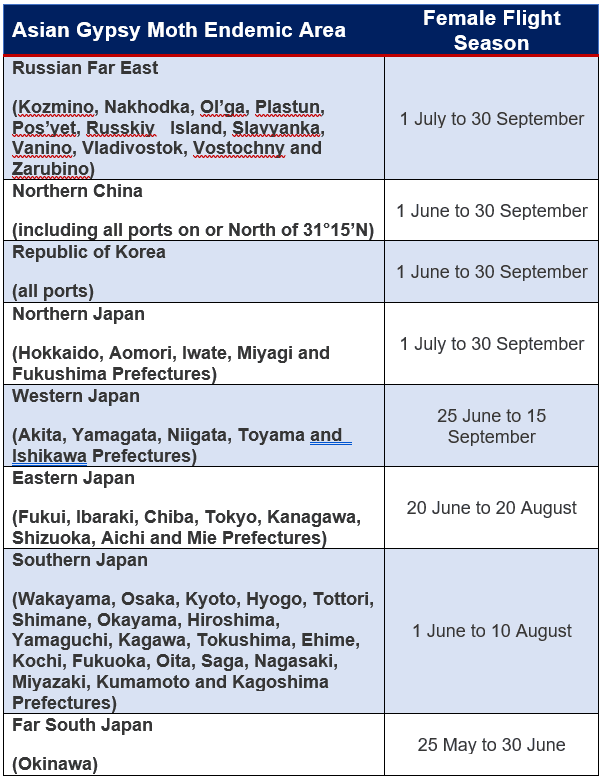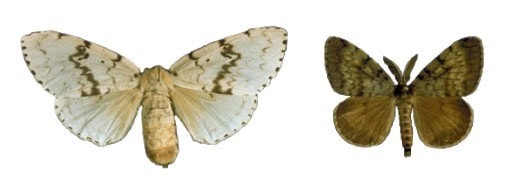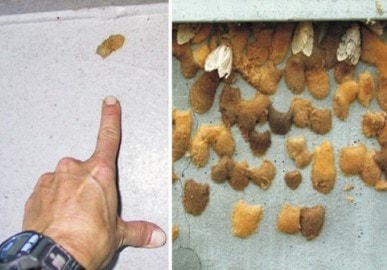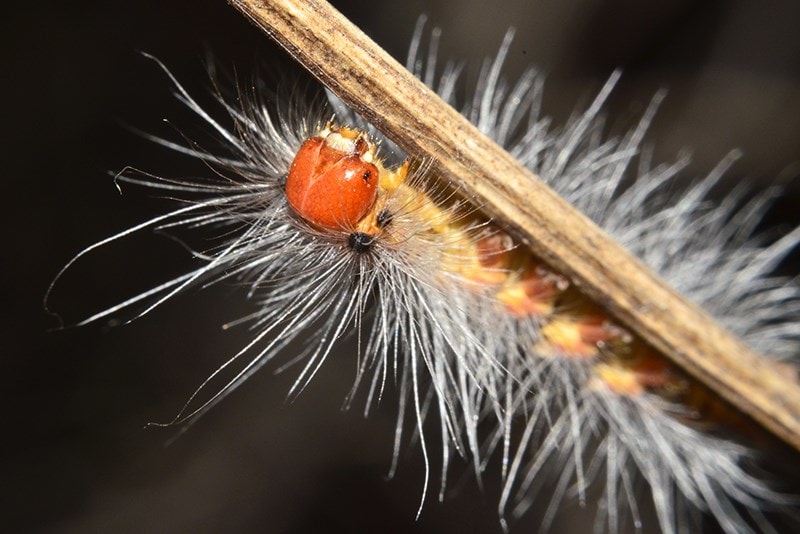Asian Gypsy Moth Update 2020
All vessels calling at ports in the Asia Pacific region between May and September should be inspected and “certified free of Asian Gypsy Moth” prior to their departure.
Introduction
The Asian Gypsy Moth (AGM, including Lymantria dispar asiatica, Lymantria dispar japonica, Lymantria albescens, Lymantria umbrosa, Lymantria postalba) is a highly destructive forest pest that feeds on both deciduous and coniferous trees.
The voracious appetite of AGM larvae (caterpillars) coupled with the ability of the female moth to travel significant distances (as much as 20 nautical miles) can cause widespread defoliation leaving trees weakened and susceptible to disease and other pests.
AGM is found primarily in the Far East with a high risk of AGM egg infestation of vessels calling at ports in Korea, Northern China (north of Shanghai; ports north of latitude 31˚15’N), and in particular the Russian Far East and Japan during the flight season of the female moth.
Due to their destructive nature, particularly in countries where the pest is not indigenous, the following countries have specific procedures in place to prevent AGM from entering their fragile ecosystem:
- Australia
- Canada
- Chile
- New Zealand
- United States
AGM Flight Season
The main concern to countries attempting to prevent the introduction of the AGM are vessels that have called at ports in the AGM High Risk Area during the previous years “flight season”.
The specific timing of the “flight season” differs from country to country. Canada and the United States base their AGM policy on the following areas and flight seasons:

Australia, Chile and New Zealand have their own designated flight season areas and dates, which differ slightly from the above.
Asian Gypsy Moth Characteristics
Male AGMs are greyish brown with a wingspan of 30 to 40 mm. Females are whitish / pale yellow in colour with prominent black marks on the wings and are larger than the male with a wingspan of 40 to 70 mm.

Image courtesy of U.S. CBP
It is unlikely that live AGMs will be encountered by vessels in transit. It is more likely that egg masses will be found.
Female AGMs are active flyers and are attracted to bright lights, therefore AGM eggs may be found in the vicinity of exterior lights and floodlights on vessels. If powerful shore lights are directed towards the vessel, AGM eggs may be found all over the ship and its cargo. Where safe and practicable to do so, external lights on vessels should be switched off.

AGM eggs are velvety in texture and range in colour from light tan to dark brown. A typical egg mass will contain between 500 and 1000 eggs and measure approximately 20 mm by 40 mm. The eggs are particularly hardy and resistant to changes of temperature and moisture. They are normally deposited in sheltered locations, for example, under canvas covers, around light fixtures and underneath framing arrangements such as hatch coamings and the underside of bridge wings. Egg masses have also been found on mooring lines, on the outside of shipping containers and on vehicles, for example in wheel arches.
The larvae normally hatch in early spring, therefore this is considered the high risk period in countries that wish to stop this species becoming established, hence vessels that call in the Far East during the flight season, and then subsequently arrive in port during the hatching period, are of particular concern.
The peak period for egg hatching is in the morning; the dispersing larvae move towards vertical structures, climb rapidly to a high point and are then widely dispersed on silken strands by the wind until they find suitable host trees to feed on, a process known as “Ballooning”.
Inspections
The inspection of vessels for the presence of egg masses, their removal and disposal are the principal tools in preventing AGM becoming established in new regions.
“Some destination countries require vessels that have called in high risk countries during the flight season to be inspected and certified free of AGM by a nominated authority immediately prior to departure”.
If no signs of AGM infestation are found, the nominated authority will issue the vessel with certification stating that it is free of AGMs; depending on the issuing authority the certificate may be a “Certificate of Inspection of Freedom from the Asian Gypsy Moth” or a “Phytosanitary Certificate”.
If multiple ports in the same country or a number of ports in different countries within the high risk area are visited during the flight seasons, the official inspection should be undertaken immediately prior to departure from the last port in the high risk area during the applicable flight season.
Regardless of any requirement for an official inspection, in order to mitigate the risk of infestation when calling at ports in the high-risk area during the AGM flight season, vessels are advised to:
- Carry out a thorough visual inspection of the accommodation superstructure, decks, deck machinery, holds, cargo and cargo gear immediately prior to departure. Binoculars can be used to inspect difficult to reach areas of the vessel’s superstructure, such as the underside of bridge wings. Similarly, a small mirror attached to a stick may be used to inspect areas that are difficult to see, for example, behind pipework next to the hatch coaming.
- Carry out another thorough visual inspection while on passage to the destination port.
- Scrape off any egg masses that are found. Do not paint over them as this will not kill them. Do not remove them using high pressure water guns as some eggs may be washed over the side and immersion in saltwater does not kill them; there have been cases of AGM eggs floating to shore and continuing to develop and hatch.
- Prior to arrival destroy any egg masses that have been scraped off. Eggs may be destroyed by placing them in alcohol, boiling them in water, freezing them or by incineration.
- Record details of all visual inspections and the removal and disposal of AGM eggs in the vessel’s deck logbook.
Country Specific Requirements
When proceeding to any of the following countries after having visited the high-risk area during the female flight season, the specific requirements of the destination should be followed:
Argentina
The Argentinian National Service for Health and Agrifood Quality (SENASA) is in the process of finalising approval and issuance of a resolution that will establish national AGM control measures.
However, the Contaminant Plague Related to Foreign Trade by Vessel Lymantria Dispar requirements is essentially the same as the control measures implemented by other nations.
Although these requirements are not yet mandatory, it is expected to come into force 90 days after its official announcement and publication.

Chile
The Requirements are set out in Resolution 4412/2013 – Phytosanitary Requirements for Vessels Arriving from Areas with Asian Gypsy Moth Presence, as amended by Resolution No.8870/2015 – Modified Phytosanitary Requirements for Vessels Arriving from Areas with Asian Gypsy Moth Presence.
It should be noted that the 2015 amendment appears to make the AGM requirements apply to all of China north of 20°N (not north of 31°15’N, as per the requirements of other countries with measures in place to stop the introduction of the AGM).
The Club has seen this interpretation of the requirements by the Chilean SAG (Agriculture and Livestock Service), with a vessel which had called at a port in southern China during the flight season being required to produce a phytosanitary certificate.
USA and Canada
AGM requirements are set out in the Asian Gypsy Moth Notice issued January 2020 jointly by the Canadian Food Inspection Agency (CFIA) and the United States Department of Agriculture (USDA).
New Zealand
AGM requirements are set out in part 3 of the Craft Risk Management Standard (CRMS) - Vessels. Further details can be found in the Guidance Document to the CRMS for Vessels, and on the following Biosecurity New Zealand webpage, which includes a link to a list of approved AGM inspection bodies: Hitchhiker pests.
The Ministry fro Primary Industries has also published a Fact Sheet to assist Owners and Operators of Commercial Vessels.
Australia
The latest Department of Agriculture and Water Resources requirements are detailed in the below Industry Advice Notice:
06-2018 – Commencement of Asian Gypsy Moth Vessel Assessment and Inspection Arrangements. (Reviewed on 4th November 2019)
All relevant vessels will be sent an AGM questionnaire through the Maritime Arrivals Reporting System (MARS), as part of their Pre-Arrival Reporting (PAR) process.
AGM Charter Party Clause
When negotiating charter parties, Members may wish to include the following clause if the vessel could be required to call at ports in the high-risk region during the flight period:
“Should Charterers order the vessel to a port, place, country or area infested by Asian Gypsy Moth ("AGM") or where there is risk of exposure to infestation by AGM as reasonably determined by the Master, Charterers shall take all reasonable steps at their time and expense to ensure that the vessel does not become infested. Without prejudice to this obligation, Charterers shall, at their time and expense, arrange for the appropriate certificate stating that the vessel is free from infestation by AGM, its larvae or eggs to be issued by an appropriate and recognised authority to the satisfaction of the Master just prior to departure from the last port of call within the high risk area during the flight season. Notwithstanding the issuing of such a certificate, Charterers will be responsible for any consequences whatsoever, including but not limited to time, costs and third party liabilities to cargo interests etc., howsoever arising, and the vessel to remain on hire/laytime to count (as applicable) should an infestation of AGM be found or suspected and/or should delays or costs be incurred due to charterers having ordered the vessel to call at a port, place, country or area where the presence of AGM is known or suspected.”
Additional Information
West News: Argentina: New Regulation in Respect of Asian Gypsy Moth
Additional information on the AGM can be found in the: Gypsy Moth Inspectional Pocket Guide
Members requiring further guidance or assistance should contact the Loss Prevention Department.